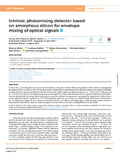Citation link:
10.1063/5.0149024| DC Field | Value | Language |
|---|---|---|
| crisitem.author.orcid | 0000-0002-2080-5143 | - |
| crisitem.author.orcid | 0000-0002-7487-1373 | - |
| crisitem.author.orcid | 0009-0001-7734-208X | - |
| crisitem.author.orcid | 0000-0001-6415-0364 | - |
| crisitem.author.orcid | 0000-0001-5875-556X | - |
| dc.contributor.author | Müller, Maurice | - |
| dc.contributor.author | Bablich, Andreas | - |
| dc.contributor.author | Bornemann, Rainer | - |
| dc.contributor.author | Marrenbach, Nils | - |
| dc.contributor.author | Kienitz, Paul | - |
| dc.contributor.author | Haring Bolívar, Peter | - |
| dc.date.accessioned | 2023-12-20T14:28:47Z | - |
| dc.date.available | 2023-12-20T14:28:47Z | - |
| dc.date.issued | 2023 | de |
| dc.description | Finanziert aus dem DFG-geförderten Open-Access-Publikationsfonds der Universität Siegen für Zeitschriftenartikel | de |
| dc.description.abstract | In this work, a promising device for direct optical envelope mixing, the Intrinsic Photomixing Detector (IPD) based on hydrogenated amorphous silicon, is reported. The IPD directly generates a photocurrent proportional to the nonlinear mixing of two optical modulation envelope functions. Experiments illustrate efficient mixing in the visible range at low light levels down to ϕ1 = 4.36 mW/cm2 (444 nm) and ϕ2 = 1.03 mW/cm2 (636 nm). Modulation frequencies exceeding the MHz range are demonstrated. Electro-optical simulations identify defectinduced electrical field screening within the absorber to cause the nonlinear mixing process, opening-up the opportunity to tailor devices toward application-specific requirements. The IPD functionality paves the way toward very simple but high-performance photodetectors for 3D imaging and ranging for direct optical convolutional sensors or for efficient optical logic gates. Using amorphous silicon provides a photodetector material base, which can easily be integrated on top of silicon electronics, enabling fill factors of up to 100%. | en |
| dc.description.abstract | In dieser Arbeit wird ein vielversprechendes Gerät für die direkte optische Hüllkurvenmischung, der Intrinsic Photomixing Detector (IPD) auf der Grundlage von hydriertem amorphem Silizium, wird berichtet. Der IPD erzeugt direkt einen Photostrom, der proportional zur nichtlinearen Mischung von zwei optischen Modulations Hüllkurvenfunktionen. Experimente zeigen eine effiziente Mischung im sichtbaren Bereich bei niedrigen Lichtstärken bis zu ϕ1 = 4,36 mW/cm2 (444 nm) und ϕ2 = 1,03 mW/cm2 (636 nm). Es wurden Modulationsfrequenzen jenseits des MHz-Bereichs nachgewiesen. Elektro-optische Simulationen zeigen, dass die Defekt-induzierte elektrische Feldabschirmung innerhalb des Absorbers als Ursache für den nichtlinearen Mischprozess, was die Möglichkeit eröffnet, die Bauelemente auf anwendungsspezifische Anforderungen zuzuschneiden. Die IPD-Funktionalität ebnet den Weg zu sehr einfachen, aber leistungsstarken Photodetektoren für 3D-Bildgebung und Entfernungsmessung, für direkte optische Faltungssensoren oder für effiziente optische Logikgatter. Die Verwendung von amorphem Silizium bietet eine Photodetektor-Materialbasis, die leicht über Siliziumelektronik integriert werden kann und Füllfaktoren von bis zu 100 % ermöglicht. | de |
| dc.identifier.doi | 10.1063/5.0149024 | de |
| dc.identifier.uri | https://dspace.ub.uni-siegen.de/handle/ubsi/2580 | - |
| dc.identifier.urn | urn:nbn:de:hbz:467-25803 | - |
| dc.language.iso | en | de |
| dc.source | APL Photonics ; 8, 086101. - https://doi.org/10.1063/5.0149024 | de |
| dc.subject.ddc | 621.3 Elektrotechnik, Elektronik | de |
| dc.subject.other | Nonlinear systems | en |
| dc.subject.other | Photodiodes | en |
| dc.subject.other | Frequency modulation | en |
| dc.subject.other | Electro-optics | en |
| dc.subject.other | Amorphous solids | en |
| dc.subject.other | Photoconductivity | en |
| dc.subject.other | Photodetectors | en |
| dc.subject.other | Optical computing | en |
| dc.subject.other | Nichtlineare Systeme | de |
| dc.subject.other | Fotodioden | de |
| dc.subject.other | Frequenzmodulation | de |
| dc.subject.other | Elektro-Optik | de |
| dc.subject.other | Amorphe Festkörper | de |
| dc.subject.other | Lichtleitfähigkeit | de |
| dc.subject.other | Fotodetektoren | de |
| dc.subject.other | Optische Datenverarbeitung | de |
| dc.title | Intrinsic photomixing detector based on amorphous silicon for envelope mixing of optical signals | en |
| dc.title.alternative | Intrinsic Photomixing Detector basierend auf amorphem Silizium für Hüllkurvenmischung optischer Signale | de |
| dc.type | Article | de |
| item.fulltext | With Fulltext | - |
| ubsi.publication.affiliation | NRW-Zentrum für Sensorsysteme (ZESS) | de |
| ubsi.publication.affiliation | Department Elektrotechnik - Informatik | de |
| ubsi.source.author | AIP Publishing | de |
| ubsi.source.doi | 10.1063/5.0149024 | - |
| ubsi.source.issn | 2378-0967 | - |
| ubsi.source.issued | 2023 | de |
| ubsi.source.issuenumber | 8 | de |
| ubsi.source.link | https://publishing.aip.org/ | de |
| ubsi.source.pages | 7 | de |
| ubsi.source.place | Melville, NY, USA | de |
| ubsi.source.publisher | AIP Publishing | de |
| ubsi.source.title | APL Photonics | de |
| Appears in Collections: | Geförderte Open-Access-Publikationen | |
Files in This Item:
| File | Description | Size | Format | |
|---|---|---|---|---|
| Intrinsic_photomixing_detector.pdf | 1.03 MB | Adobe PDF |  View/Open |
This item is protected by original copyright |
Page view(s)
305
checked on Apr 3, 2025
Download(s)
56
checked on Apr 3, 2025
Google ScholarTM
Check
Altmetric
Items in DSpace are protected by copyright, with all rights reserved, unless otherwise indicated.

